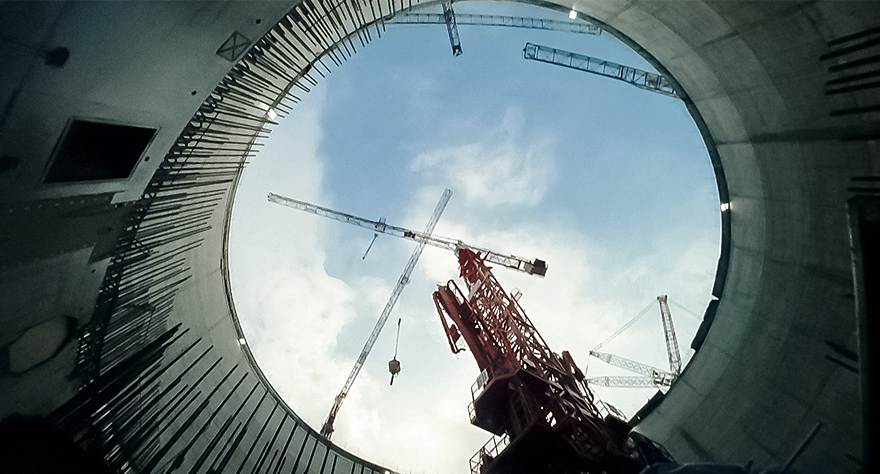
An earnest but tepid and tedious attempt to record an immensely important and criminally under-discussed moment in the progression of the 21st century.

An earnest but tepid and tedious attempt to record an immensely important and criminally under-discussed moment in the progression of the 21st century.
In 2005, in the small Finnish town of Eurajoki, construction began on the country’s third nuclear reactor, the first to be built by the Western world since the Chernobyl disaster of 1986. The plant, commonly referred to as OL3, was set to join the first two units of the Olkiluoto Nuclear Power Plant, which were situated just outside of town on a small island in the Gulf of Bothnia. In the early years of the project, the town was ecstatic to have won yet another plant. But in the tiresome and decisive years that followed, as the construction fell further and further behind schedule and the cost soared to unprecedented levels, tension rippled through the close-knit community, and a global conversation about the merits of nuclear power versus high carbon-emitting power plants grew fierce. This is the inherently dramatic and timely story that the tepid and tedious The Return of the Atom attempts to capture.
The new documentary from Mika Taanila and Jussi Eerola picks up in the first days of construction, highlighting the energy and eagerness of the small community. A major contract such as the OL3 means jobs and money for these sorts of towns. It also means proudly supplying up to a fifth of Finland’s power. But despite the overall excitement, some live in great fear of the potential death and environmental disaster next door.
Taanila and Eerola follow a handful of key players in the events of the following eight years. They also attempt to map out what sort of town Eurajoki is. Despite their efforts, however, the community remains a mysterious and elusive place. Instead, The Return Of The Atom shadows several employees and committee members fighting to keep spirits high and cost low, as their project unravels beneath them. A former Olkiluoto engineer named Arto Lauri comes out against the plant, seeing nuclear power as a powder keg that will soon destroy his home and the planet along with it.
The trouble is, for all this perfect setup, not much ever really happens. At least not on film. Construction falls almost immediately behind, and Lauri shows up at town hall meeting after town hall meeting to voice his dissent despite the lack of interest from just about anyone else. And time and again, we watch interviewees stare regretfully into the distance as they struggle to continue pushing the plant’s propaganda. But never do we get close to anyone or any particular piece of this complex puzzle. And never do we truly get a chance to explore, let alone even ask, the dire questions related to nuclear power and the encroach of global warming. What we get instead are what feel like dozens of montages of dizzying construction scenes to the pulse and grind of Pan Sonic’s overly serious score—a score that seems to want to imbue the gravity of the situation that the film itself can never quite articulate.
In fact, it feels almost as though Taanila and Eerola, who shot the film over the course of eight years, were always showing up just after something interesting happened. If only we could have spent more time with Lauri. The growth of his obsession, even in the film’s periphery, is heart wrenching: he refuses to give up but never seems to find anyone who will truly listen. His is a character ripe for study, and The Return Of The Atom misses its chance.
Running an overlong 110 minutes, there is the sense that the film, unsure of what it is truly about, is hoping to pack in so much from so many disparate places, that some sum greater than its parts will emerge. The Return Of The Atom is a pressure cooker of a build. At its core, the film is set up to be some sort of thriller, unfolding over nearly a decade, with the hope that something great will have happened by the end. But there never is any moment of confrontation. Lauri is, in a small way, vindicated, but nothing grand ever comes of the strife surrounding the plant (which is certainly no spoiler). Nor is there ever a moment of catharsis.
Such endeavors for any documentary filmmaker are risky. Taanila and Eerola got in on the ground floor with no idea of what would come of things in Eurajoki. Certainly there would be conflict. Certainly there would be tension. But the question of what else the directors were looking for must be asked. Did they only want to see what would happen? Or did they want to explore the enormous possibilities and immense potential for true disaster (like the one that strikes Fukushima near the film’s close)? The Return Of The Atom is an earnest attempt to record an immensely important and criminally under-discussed moment in the progression of the 21st century. But it could stand to have been more present for it.